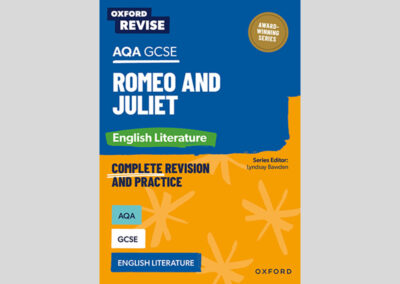AQA GCSE English Literature: Romeo and Juliet Glossary
The key vocabulary you need to learn for your AQA GCSE English Literature: Romeo and Juliet paper. Find all the terms and definitions you need to understand, from ‘BAWDY’ to ‘TRAGEDY’.
B - C (BAWDY to COURTLY LOVE)
Bawdy means coarse, rude, or lewd.
blank verse
Blank verse is unrhymed poetry, usually written in iambic pentameter (often used in Shakespearean plays).
character arc
The character arc refers to the ‘journey’ of a character – how they begin, develop, and end in the story.
chorus
In Elizabethan drama, the chorus is an actor who recites the Prologue and may comment as an observer at other times on the action of the play.
climax
The climax of a narrative is the point of greatest excitement.
conflict
Conflict is a dramatic device which prevents a character from achieving their goal by introducing disagreement, such as a problem or struggle.
counterpoint
Counterpoint means bringing in a contrasting element, with the effect of emphasising the thing it is presented as opposite to.
courtly love
Courtly love is a medieval concept which emphasised noble and chivalrous behaviour in romantic love, rather than physical contact.
D - E (DRAMATIC DEVICE to EXTENDED METAPHOR)
A dramatic device is a technique used to create tension, emotion, or drama in a narrative, such as dramatic irony, conflict, foreshadowing, plot twists, soliloquies, or asides.
dramatic irony
Dramatic irony is when the words or action of the play are understood by the audience but not by one or more of the characters on stage.
dramatic structure
The dramatic structure of a play is the way events are organised, such as exposition, rising action, climax, falling action, and resolution.
extended metaphor
An extended metaphor is when a writer describes something as if it were something else, and does so by making several different points of comparison, often over more than one sentence.
F - I (FORESHADOWING to INNUENDO)
Foreshadowing is the fiction technique of making the reader anticipate events that will happen later, as in, ‘If I had known then, I might not have done what I did next.’
genre
The genre of a text is its broad category, such as horror story, romance, or travelogue.
homophone
A homophone is where two or more words have the same sound but different meanings or spellings.
imagery
Imagery is the collective term referring to metaphors and similes.
innuendo
Innuendo is a hint or hidden reference to something rude, often sexual.
J - O (JUXTAPOSE to OXYMORON)
To juxtapose means placing two ideas or phrases next to each other in a text for comparison or contrast.
metaphor
A metaphor brings something to life imaginatively by speaking of something as if it is something else that it resembles in some way, without using ‘like’ or ‘as’.
motif
A motif in a text is a dominant or recurring idea.
oxymoron
An oxymoron is a figure of speech that combines words which hold directly opposite meanings, for example, old news.
P (PATHETIC FALLACY to PUN)
Pathetic fallacy is the literary technique of giving human feelings to inanimate things, such as the weather.
personification
Personification is a technique in which a writer describes non-human things as if they were human, as in ‘Time marches on’.
personify
To personify something is to describe it as if it were human.
portentous
When something is portentous, it has particular significance or importance in the narrative, especially as an omen of future events.
prose
Prose is any writing in continuous form without rhythm or rhyme.
protagonist
The protagonist is the main character in a story, often the one whose journey or conflict drives the plot.
pun
A pun is a type of joke or wordplay that relies on the similar sound but different meaning of words.
R - S (RESOLUTION to SONNET)
The resolution of a play is the end section where a problem is resolved.
revelation
A revelation is a point in a story where something important is revealed.
rhyming couplet
A rhyming couplet is two consecutive lines that rhyme.
soliloquy
A soliloquy is where one character speaks alone and voices aloud their innermost thoughts for the audience to hear.
sonnet
A sonnet is a 14-line poem with a specific structure and rhyme scheme, often exploring the theme of love.
T (TENSION to TRAGEDY)
Tension in a text can refer to the sense of conflict between characters or the feeling of anxiety generated in readers about the text’s outcome. In most fictional texts the tension is ultimately resolved, though not necessarily by a happy ending.
tragedy
Tragedy is a genre of play that focuses on a main character who suffers and fails because of their own flaws, often also combined with factors beyond their control.
